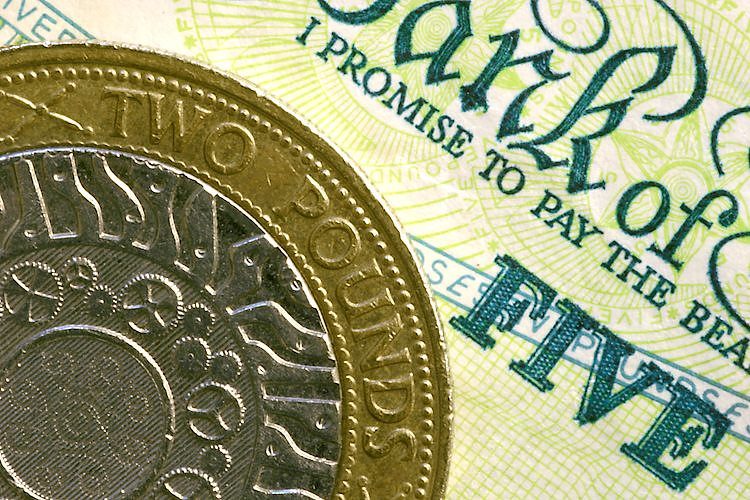Pound Sterling eyes downside as recession risks elevated
- Pound Sterling prepares for further rally as market mood remains upbeat.
- UK’s business confidence improves as firms expect interest rates to peak sooner.
- Lloyds Bank Business Barometer shows that businesses will keep raising wages and prices ahead.

The Pound Sterling (GBP) demonstrates a corrective move as investors seek fresh cues about the interest rate peak from the Bank of England (BoE) for further guidance. The GBP/USD pair eases some gains inspired by bullish market sentiment and expectations that the 15th consecutive interest rate hike by the BoE will neutralize its policy divergence with the US Federal Reserve (Fed).
UK’s business confidence saw a surprising boost in August as firms hope that interest rates by the central bank will peak sooner. Corporations seem confident about the economic outlook and conveyed that wage growth will continue to remain strong and prices of goods and services at factory gates will elevate further. This could add worries for BoE policymakers, who are working relentlessly to achieve price stability.
Daily Digest Market Movers: Pound Sterling faces pressure ahead of key labor data
- Pound Sterling corrected below the round-level support of 1.2700 after Bank of England Chief Economist Huw delivered a hawkish commentary. BoE Pill said on Thursday that policy must be sufficiently restrictive for long enough.
- The asset dropped despite the BoE preparing to raise interest rates further in September due to the UK economy having the highest inflation among G7 economies.
- Investors hope that the BoE will raise interest rates consecutively for the 15th time. An interest rate hike of 25 basis points (bps) is expected, which will push interest rates to 5.5%.
- Market participants remain worried that the UK’s demand environment is deteriorating due to the historically aggressive policy-tightening spell by the central bank.
- UK construction activities, Manufacturing PMI, and housing demand are facing the wrath of BoE’s higher interest rates.
- Firms and home-buyers have postponed their expansion plans and investment in housing respectively to avoid higher interest rates.
- In spite of the dismal economic outlook, the survey from Lloyds Bank Business Barometer showed that business confidence jumped by 10 points in August to 41%, its highest since Russia’s invasion of Ukraine.
- Hann-Ju Ho, senior economist at Lloyds Bank, said “Our analysis shows that businesses felt relief that interest rates may be reaching their peak, alongside hopes that measures to tackle inflation are having an impact."
- The survey also showed that businesses will keep raising wages and prices of goods and services at factory gates, which will add worries for BoE policymakers who are investing blood and sweat to bring inflation down.
- Investors are anticipating that interest rates by the BoE will peak at 5.75%.
- The market mood remains upbeat as hiring momentum by United States firms slowed, demonstrated by weak Job Openings for July and downbeat ADP Employment Change data for August.
- US Bureau of Labor Statistics reported on Tuesday that employers invited applications for 8.827M vacancies vs. June’s reading of 9.165M. ADP reported that new hires arrived at 177K in August, significantly lower than July’s reading of 324K. Investors had projected 195K new private payrolls.
- A slowdown in labor demand is evident that the US labor market is losing its resilience, which could allow the Fed to end its string of rate hikes and usher in a soft landing.
- Latest labor market data has boosted hopes of a steady interest rate decision to be considered by the Fed for its September monetary policy.
- Chances that the Fed will keep interest rates at 5.25-5.50% by year-end have improved. Fed Chair Jerome Powell conveyed last week that inflation is getting more responsive to the labor market. Easing labor market conditions could keep inflationary pressures under control.
- The US Dollar Index maintains strength as US Personal Consumption Expenditure (PCE) price index turns out persistent.
- For further action, investors will focus on the US Nonfarm Payrolls (NFP) and ISM Manufacturing PMI data, which will be published on Friday.
Technical Analysis: Pound Sterling stabilizes below 1.2700
Pound Sterling skids below the round-level support of 1.2700 as the US Dollar extends recovery. The Cable delivers a mean-reversion move near the 20 and 50-day Exponential Moving Averages (EMAs). For a confident recovery, the asset has to stabilize above the aforementioned EMAs. Momentum oscillators are demonstrating that the bearish impulse has faded for now.
BoE FAQs
What does the Bank of England do and how does it impact the Pound?
The Bank of England (BoE) decides monetary policy for the United Kingdom. Its primary goal is to achieve ‘price stability’, or a steady inflation rate of 2%. Its tool for achieving this is via the adjustment of base lending rates. The BoE sets the rate at which it lends to commercial banks and banks lend to each other, determining the level of interest rates in the economy overall. This also impacts the value of the Pound Sterling (GBP).
How does the Bank of England’s monetary policy influence Sterling?
When inflation is above the Bank of England’s target it responds by raising interest rates, making it more expensive for people and businesses to access credit. This is positive for the Pound Sterling because higher interest rates make the UK a more attractive place for global investors to park their money. When inflation falls below target, it is a sign economic growth is slowing, and the BoE will consider lowering interest rates to cheapen credit in the hope businesses will borrow to invest in growth-generating projects – a negative for the Pound Sterling.
What is Quantitative Easing (QE) and how does it affect the Pound?
In extreme situations, the Bank of England can enact a policy called Quantitative Easing (QE). QE is the process by which the BoE substantially increases the flow of credit in a stuck financial system. QE is a last resort policy when lowering interest rates will not achieve the necessary result. The process of QE involves the BoE printing money to buy assets – usually government or AAA-rated corporate bonds – from banks and other financial institutions. QE usually results in a weaker Pound Sterling.
What is Quantitative tightening (QT) and how does it affect the Pound Sterling?
Quantitative tightening (QT) is the reverse of QE, enacted when the economy is strengthening and inflation starts rising. Whilst in QE the Bank of England (BoE) purchases government and corporate bonds from financial institutions to encourage them to lend; in QT, the BoE stops buying more bonds, and stops reinvesting the principal maturing on the bonds it already holds. It is usually positive for the Pound Sterling.
Author

Sagar Dua
FXStreet
Sagar Dua is associated with the financial markets from his college days. Along with pursuing post-graduation in Commerce in 2014, he started his markets training with chart analysis.

















